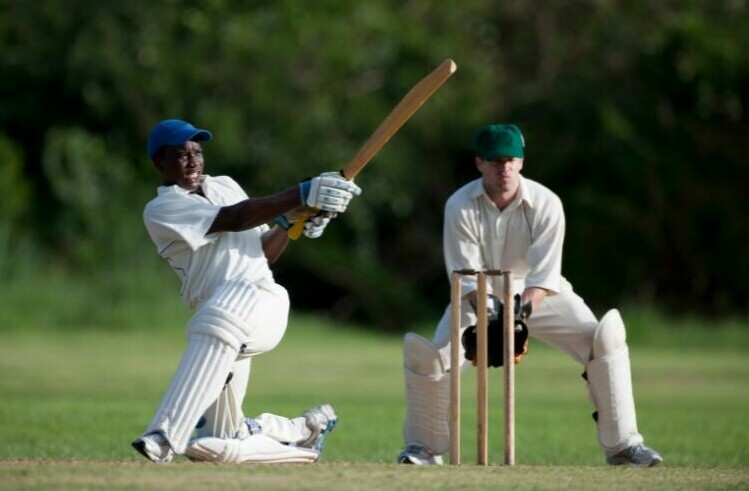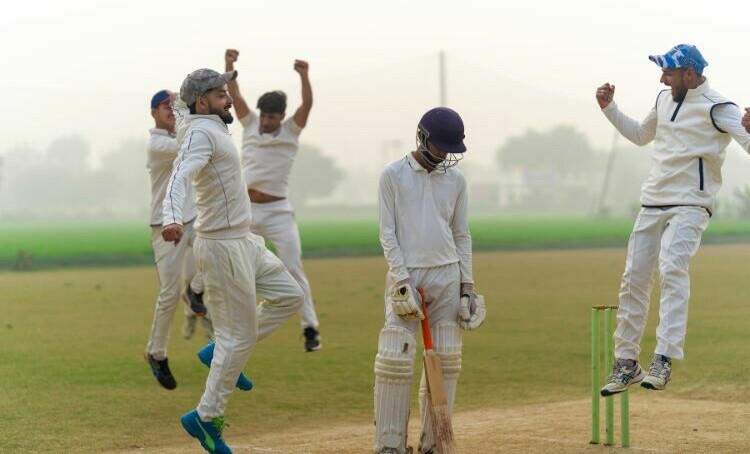Versatility in a player’s batting arsenal can profoundly impact their effectiveness and adaptability at the cricket pitch. The Sweep Shot stands out as a tactical tool that can shift the momentum of the game and challenge the strategies of even the most seasoned bowlers.
It is a complex shot, requiring practice to get right, and if done wrong, it can make the batter look silly. But if performed correctly, it can give the batter a way to combat high quality spin bowling.
The sweep shot is primarily used against spin bowling, although there are a few brave (possibly foolhardy, depending if it comes off) batters that have managed to sweep fast bowlers. It allows you, as the batter, to manipulate the field, to combat difficult bowling and to navigate challenging pitch conditions effectively. The ability to switch tactics and shots not only keeps the bowler guessing but makes it harder for the fielding captain to set fields to you.
Explaining the Sweep Shot

The shot, in its simplest terms, involves you kneeling on one knee and using a horizontal bat to hit a ball pitched at or around leg stump to the square leg or fine leg area. The sweep shot is often used on a turning pitch to combat the dangers of the spinning ball.
A ball pitched on the leg stump is, probably, the easiest to sweep. It reduces the risk of LBW if you miss it, but batters will also sweep balls bowled on or even outside off stump, although the risk of mistakes increase.
Off spinning balls that are pitching on leg stump are usually very safe to sweep, as the direction of the ball will miss the stumps. However, it is leg spinning balls that are the easiest to sweep, because they are spinning towards the bat as you play the shot.
Sweeps can be hit along the ground, if you roll your wrists at the time of contact, or can be hit into the stands for six if you are daring.
Understanding the Different Variations
There are different versions of the sweep shot. The conventional sweep, which is what this blog will discuss, and then there is the reverse sweep.
The reverse sweep is a more modern adaptation of the sweep shot that involves you reversing the bat’s face towards the off side; if you are a right hander, this effectively turns into a left-handed sweep shot, although usually played with a right-handed foot positioning. It is a very difficult shot to master and easy to get wrong, but it is very useful in that fielding positions very rarely cater specifically for it.
A second variation is the paddle sweep, which is a finer and more delicate version of the sweep. It involves getting into a similar position as the sweep, but instead of a full sweep shot, you gently tap the ball, guiding it to very fine leg, using the pace of the ball rather than your own power to get it to the boundary.
Executing the Perfect Sweep
Mastering the sweep shot requires attention to detail in several key aspects of batting technique, from body posture to precise timing.
Positioning: As the bowler delivers, you will need to judge the line and length of the ball as early as possible. It’s crucial to decide quickly whether the ball is suitable for a sweep.
Movement: Your front foot should take a long stride towards the pitch of the ball, while you simultaneously drop down on your back knee. Your front knee should ideally be in line with the off-stump to cover the line of the ball.
Bat Placement: Bring the bat down in a sweeping motion, keeping it as horizontal as possible. The aim is to connect with the ball well in front of your pads – about an arm’s length. If you want to keep the ball down, roll your wrists at the time you strike the ball.
The Keys to a Powerful Sweep Shot
Body Posture and Balance: Maintaining a low centre of gravity is vital. This is achieved by keeping your head down and over the knee; this stabilizes your upper body. Your back should be slightly arched, and your shoulders level to enable a full, controlled swing of the bat.
Balance is crucial, as losing it could lead to a mis-hit or a fall, making you vulnerable to being stumped or bowled.
Head and Eye Coordination: Your eyes should focus on the ball until the moment of impact. Keeping your head still and aligned with the sweep shot will help in maintaining your balance and will also enhance the accuracy of the hit. This coordination is critical for effectively redirecting the ball into gaps in the field.
Footwork and Precision Timing: You need to move your feet quickly and accurately to get into the correct position to play the sweep shot. Timing is equally crucial; if you strike the ball too early or too late, you may end up top edging the ball to a fieldsman or missing the ball entirely and being bowled or stumped if you’ve lost balance and have fallen outside of the crease.
Knowing When to Play The Sweep Shot
The sweep shot is not just a display of your skill, but it is also a strategic tool to include in batting repertoire. Knowing when to sweep and when not to can dictate the success of the shot and whether you continue your battle with the bowler or he celebrates an easy wicket.
Match Conditions: The decision to play a sweep shot should consider factors like the state of the pitch, the match situation and the current phase of the innings. On a turning track where spinners are getting extra bounce and turn, the sweep can be an effective method to disrupt their line and length. Also, in a tightly contested match, using the sweep to counter a defensive field setting can help in keeping the scoreboard ticking or in chasing down a target.
Identifying Which Bowler To Play A Sweep Shot To: Obviously, spin bowlers are usually the best candidates for playing the sweep shot against. However, the sweep shot is safest to play for balls that are pitched on or outside leg stump, as the risk of LBW is less. It is possible to play sweep shots to balls that are pitching outside off stump, but it is a far riskier shot to perform.
Balancing Risks vs Rewards: The sweep can be a high-reward shot, but it carries inherent risks. As mentioned above, the least risky ball to sweep is one that is pitching on or outside leg stump. Additionally, a pitch with true bounce is best to sweep on, as a pitch with inconsistent bounce could easily produce a ball that goes under the bat, or one that bounces just slightly more than expected and hits the top edge.
Also, take note of the field placements. If the field is heavily packed on the leg side, you are just playing into the fielding team’s hands by playing a sweep shot into a packed field.
Common Mistakes and Ways to Fix Them

One common mistake is attempting to sweep a delivery that is unsuitable for the sweep shot. The line and length, as mentioned previously, is very important. If the ball is too full, too short, or pitched too far towards the off-side, you are far more likely to not be in control of the shot, unless you are very proficient at the sweep.
Another error is improper body positioning. If you fail to get low enough or you don’t align your head and knee in the proper way, this can result in difficulty maintaining balance and any semblance of control on the shot.
A third common error is incorrect bat angle at the point of contact. Unless you are wanting to hit it aerially, you will want to roll your wrists at the point of contact to keep the ball on the ground.
How to avoid common errors: Practice and focus. Practice and focus. To get the sweep shot right, you need to have performed it thousands of times in the nets, and then, when you are playing it, your focus on determining the right ball to sweep needs to be complete. The sweep shot is an odd shot; at first, it won’t feel natural.
So try it again and again, getting your front leg far down the pitch, lowering yourself on to your back knee, and the swinging the bat horizontal across the ground in a sweeping motion, and then rolling your wrists as the bat contacts the ball … it’s far different to any of the other shots we’ve been posting on, and needs to be treated with respect and patience.
Last Word on the Sweep Shot
The sweep shot is a difficult shot. There are many very good international batters who do not bother with the sweep shot. They combat spin bowling with quick footwork either forwards or backwards, or advancing down the pitch to meet the ball on the full or nears its bounce to negate the spin.
So, don’t feel pressure to learn it if it doesn’t feel comfortable or natural. But you should still find a way to combat spin bowler; if you constantly block, the spin bowler will gain confidence as they know you aren’t looking to score from them. And if you constantly swing the fences, you are likely to miss hit one, or miss it entirely.
In your practice, use a bowling machine set to deliver spin at varying lengths; this will allow you to practice the movement, timing and execution of the shot under controlled conditions.
And always talk with your coaches and ask for their help. Use the hours and hours of video available of professionals playing the sweep shot and study them, trying to learn the intricacies of the shot.
Through dedicated practice, focusing on correcting frequent mistakes, and leveraging professional guidance and technology, you can significantly improve your sweep shot technical, making it a reliable and powerful tool in your cricketing arsenal.
Who is the best proponent of the sweep shot you’ve seen? Talk about them in the comments, and let’s reminisce.

